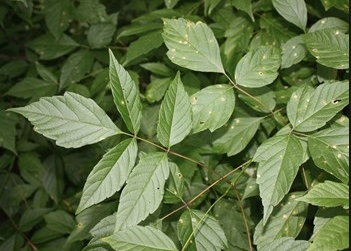![By Tom Murphy VII (Taken by user user:brighterorange.) [GFDL (http://www.gnu.org/copyleft/fdl.html), CC-BY-SA-3.0 (http://creativecommons.org/licenses/by-sa/3.0/) or CC BY 2.5 (https://creativecommons.org/licenses/by/2.5)], via Wikimedia Commons Boxelder bug on green leaf. CC-BY-SA-3.0 (http://creativecommons.org/licenses/by-sa/3.0/) or CC BY 2.5 (https://creativecommons.org/licenses/by/2.5)]](https://westerngardens.com/wp-content/uploads/BoxElder-Bug-Way-to-Control-4-2018-FB-1024x576.jpg)
By Tom Murphy VII on WikimediaCommons
Boxelder bugs are most numerous in areas where boxelder, silver maple, ash, and fruit trees grow. Their main source of food is from sucking the juice from the boxelder tree, which does not damage the tree. In the early spring, the female bugs lay their eggs on the bark of these trees. The new little hatchlings are called nymphs and are about ¼ inch long and have bright red wingless bodies with black legs. Nymphs congregate in mass, so it’s easy to spot them on the trunk of a tree, building foundation, or wherever. The young feed on tender twigs, foliage, pollen, and seeds through the spring and summer. Controlling the nymphs is easier than controlling the adults so watch this spring to get a jump on them.
The Boxelder bug adults grow to be about ½ inch long. They are red or black with reddish lines on their wings. In the fall, especially on bright sunny days, the bugs migrate to locations to hibernate through the winter. In the spring, they emerge to look for host trees so they can eat and lay their eggs, completing the cycle.
How to Control Boxelder Bug and/or Prevent their Annoyance
- For home invasion prevention, keep sealed doors, windows, foundation cracks, around plumbing, gas, and electrical conduits. Weather strip around doors and windows plus screen off attic vents and repair broken windows and screens. Expanding-foam sealants may be helpful too.

Photo by Pixxl Teufel on Pixabay
- Vacuum the bugs with a “shop” type vacuum, empty the vacuum and seal and dispose of the collected bugs, as they can live through the vacuuming process and will continue to creep around otherwise.

Photo by Jarmoluk on Pixabay
- Avoid smashing the bugs. They don’t feed on fabric or furniture, but when crushed, they do stain household items. They also release a strong, unpleasant odor.

Photo by Took-a-Pic on Pixabay
- Boxelder bugs, especially the nymphs, are easily drowned. When watering your plants with a garden hose, it’s also a good time to water-down congregations of bugs on buildings.
- Reduce bug populations by removal of female boxelder trees. Realize that even if you don’t have a boxelder tree on your property, chances are great that there is a Boxelder tree nearby.

Boxelder trees are often called “trash” trees. They may seem pretty and provide shade, but there are many other better choices for shade.

Boxelder tree leaves
- Boxelder bugs do not have many natural enemies. No major insects or birds like to eat them, probably because they can emit an offensive odor, which probably makes them taste bad too. Spiders could be considered a minor predator.
- Chemical control of boxelder bugs is difficult because these bugs are tolerant of most insecticides. There are some residual insecticides that can be sprayed around the outside of the building. Oil based sprays can stain building surfaces, so try to control on the host plants, not the building. Be sure to check with your local independent garden center, like Western Gardens, to know the latest and best product recommended. Always follow current label instructions of any pesticide used, as label changes occur and must control application procedures. This or any other instruction must be adjusted/disregarded so application conforms to the current pesticide container label.
- For an organic alternative to using synthetic insecticides. Mix about ½ cup laundry detergent with one gallon of water. Use a squirt bottle to spray the insects. There is no residual value so you must spray thoroughly and often.

Organic Solution
Resources: Thanks to Ortho Publications, Utah State Extension, Chuck Solomon, and G. Rex Buys of Western Garden Centers

Western Gardens
Latest posts by Western Gardens (see all)
- How to Prepare the Ground for your Garden - April 28, 2018
- Pest Control – the Annoying Box Elder Bug - April 19, 2018
- Keep Kids Safe from Poisonous Plants and Pesticides – Part 1 - April 14, 2018

